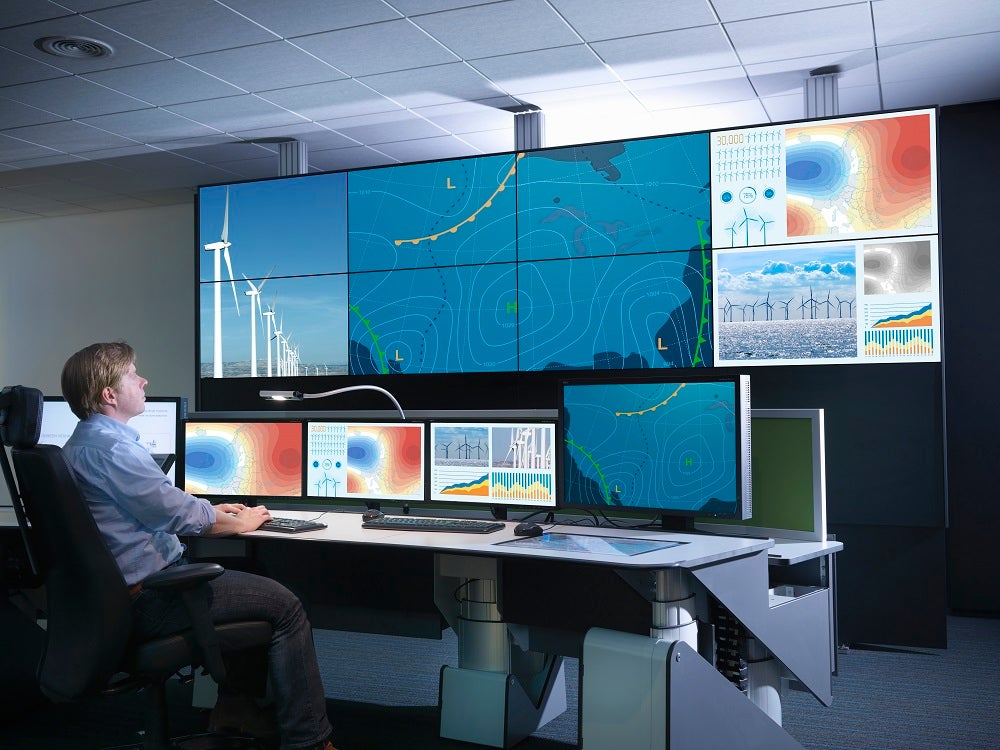
As companies throughout the energy industry seek to modernise and stay relevant during a period of massive transition, digital tools will play a key role in helping firms of all shapes and sizes embrace new ways of doing business. Stephen Wair, head of control room systems at NEC Display Solutions, gives his thoughts on the digital future.
With zero emissions targets the ultimate goal, the energy sector is under immense pressure to change as it plays its part in tackling climate change.
We are now in the year by which the UK government committed to provide 15% of energy from renewable sources and in fact, at times, we are achieving a level of up to 60%. Clean energy is becoming increasingly mainstream as the next decade brings significant challenges and opportunities for energy suppliers.
The industry is undergoing a transformation, change is mandatory and it’s happening fast.
Energy operators are dealing with increasingly complex digital environments
Managing demand and supply is a constant balancing act. Monitoring the peaks and troughs of demand and ensuring a constant supply coming from diverse energy sources is a complex process involving multiple stakeholders, which seemingly requires a crystal ball.
August 2019 saw a large-scale power outage across the UK, the disruption in electricity supply affected one million customers and resulted in power suppliers paying millions of pounds in penalties.
The incident raises questions over how efficiently the network is operating and underlines the importance of adapting to the complex and changing energy market.
Energy providers and network operators are dealing with increasingly vast and complex systems of process control alongside safety and security systems, all of which must be constantly monitored.

Maintaining smooth operation whilst ensuring rapid action should an incident occur requires instant access to information with real-time, accurate, broad and varied data sources.
Only by embracing every element of information and analysing its potential significance can operators increase their efficiency, make informed decisions and reduce the cost of power – including hefty penalties.
The impact of renewables is changing traditional industry models
The current energy system is essentially designed to distribute electricity from generation through transmission, distribution and onto consumers, avoiding congestion and bottlenecks.
The impact of renewable energy generation is changing this traditional model. Increasingly, distributed energy sources from wind turbines, solar panels and other low carbon technology are entering the network, with users having the potential to be both a producer and a consumer.
In the future, houses will be fully-connected and enabled for smart appliances, smart meters, storage and control. With an increasing number of smaller power generation sources, each with fluctuating and unpredictable supply, the way in which this is dealt with needs to change.
The distribution network operators (DNOs), responsible for energy transmission and distribution networks, are in a transition phase, moving to a more dynamic operation as distribution system operators (DSOs), equipped to manage the new energy networks of the future.
Distribution networks will transform over the next decade
This essential transition will take place over the coming decade. As DSOs, they will “securely operate and develop an active distribution system comprising networks, demand, generation and other flexible distributed energy resources. They will enable competitive access to markets and the optimal use of distributed resources on distribution networks”.
The transition will be deeply challenging in terms of infrastructure, technical and management capabilities, as well as adapting to new business models.
The key words in this role defined by the Energy Networks Association are active, flexible and competitive.
It is critical that the DSOs are well supported by technology solutions providers who understand and can support these vital characteristics.
Real-time network visibility is becoming ever more important
Increases in distributed power generation require active network management – taking on system operator functions is empowerment at the local level but it is only possible through access to new technologies and real-time data in order to make interventions on the network.
Real-time network visibility is essential to manage increasing intermittent and renewable energy generation safely, efficiently and cost-efficiently. Critical network data must be available for measurement and analysis alongside complementary data feeds such as weather forecasts, for instance, helping to increase energy supply prediction capability and support more informed network planning.
With renewable power generation now so geographically widespread and often remote, repairs and maintenance become increasingly burdensome. Remote on-site monitoring with CCTV supports the safety of solo maintenance personnel deployed to wind farms for instance, thus helping to reduce costs.
DSOs today and in the future are receiving and handling multifaceted data sources demanding complex analysis and it is only going to increase in volume, speed and diversity.
The application of the latest technologies supporting swift situational awareness via visual displays enables stakeholders to collaborate efficiently and to drive coordinated action. Improved operational intelligence will result in better and timelier decision-making whilst supporting cost saving initiatives.
Digital readiness is the key to navigating the change
Many DNOs have announced their digital strategies detailing how and when they will be making the mighty transition. The DSO model is the future of the industry and change needs to start now.
The implications are far reaching but the process need not be overwhelming. The key is to be poised to instantly adapt to change as the industry moves apace.
Digitalisation is penetrating nearly all technical and management processes. In this smart digital environment of the future, any supporting technology infrastructure must offer the versatility to morph and rescale as required, in an instant.
The management of multiple sources and the flexible mapping to an infinite number of visual outputs is of the highest importance.






